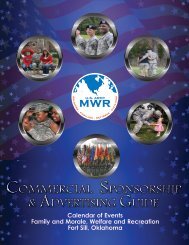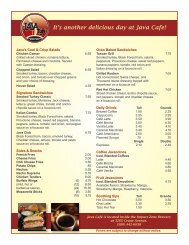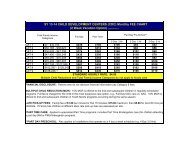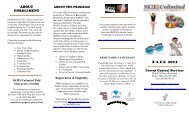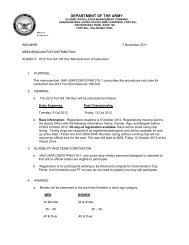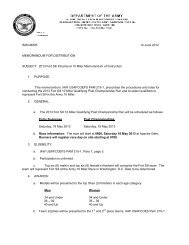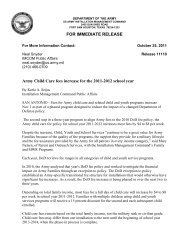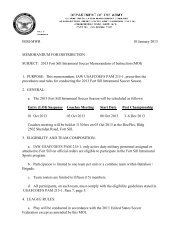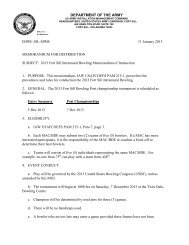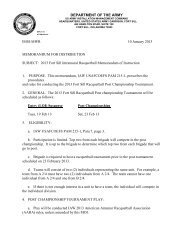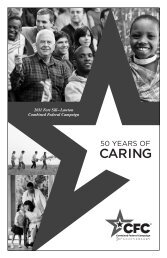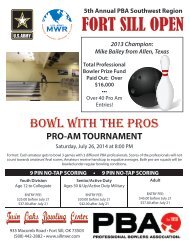Preparing and Managing Correspondence - Fort Sill MWR
Preparing and Managing Correspondence - Fort Sill MWR
Preparing and Managing Correspondence - Fort Sill MWR
You also want an ePaper? Increase the reach of your titles
YUMPU automatically turns print PDFs into web optimized ePapers that Google loves.
Section II<br />
Envelope Size<br />
5–3. Size<br />
Do not use a letter-sized envelope that measures less than 3 1 ⁄2 by 5 inches or one that measures more than 6 1 ⁄8 inches<br />
high by 11 1 ⁄2 inches long <strong>and</strong> 1 ⁄4 inch thick.<br />
5–4. Selection of envelopes<br />
a. Use the smallest available envelope that will fit the item. A close fit will provide the least chance for damage <strong>and</strong><br />
is more cost effective. Do not use large envelopes for correspondence of six pages or less unless contents warrant<br />
otherwise, for example, certificates, officer evaluation reports (OERs), <strong>and</strong> other items that may not be folded.<br />
b. Unclassified correspondence requires no envelope when sent within the same building or headquarters. The<br />
address on the face of the correspondence is sufficient.<br />
c. Table 5–1 provides specific guidelines for selecting the right envelope.<br />
d. Select envelopes for classified material according to AR 380–5.<br />
5–5. Envelopes to avoid<br />
a. Avoid using envelopes larger than 9 by 12 inches unless absolutely required.<br />
b. Do not use nonst<strong>and</strong>ard envelopes that incur excess postage.<br />
5–6. Messenger envelopes<br />
a. Use U.S. Government Messenger Envelopes (OF 65–B or OF 65–C) for—<br />
(1) Unclassified <strong>and</strong> FOUO correspondence between elements of an agency or headquarters located in different<br />
buildings in the same general area.<br />
(2) Unclassified <strong>and</strong> FOUO correspondence through official Army channels.<br />
b. Write the complete address legibly. H<strong>and</strong> print or type in the space on the envelope. Cross off the last address<br />
<strong>and</strong> reuse the envelope until it is filled out or worn out.<br />
Table 5–1<br />
Selecting the right envelope<br />
Item Size Type of mail Envelop size<br />
8 1 ⁄2 x 11 Cannot exceed 1 ⁄4-inch thickness when folded. 4 1 ⁄8 x 9 1 ⁄2<br />
8 1 ⁄2 x 11 Items that cannot be folded 8 1 ⁄2 x 11 1 ⁄2<br />
Odd size<br />
Odd size<br />
Any size<br />
Cannot be folded, for example, booklets,<br />
pamphlets, or Certificates<br />
Bulk—A number of items to the same address.<br />
Unclassified (<strong>and</strong> FOUO) mail within an<br />
agency or HQ in a different building or address<br />
through official Army channels.<br />
A size where there is no more than 1 ⁄2 inch on<br />
any of the four sides.<br />
A size to fit largest item.<br />
OF 65–B/OF 65–C (U.S. Government Messenger<br />
Envelope)<br />
Section III<br />
Addressing Mail<br />
5–7. Delivery address<br />
a. <strong>Correspondence</strong>. The address should have a uniform left margin <strong>and</strong> be legible. An effort should be made to limit<br />
the number of lines to five. Uppercase/lowercase letters are acceptable on all lines of the address block. With the<br />
exception of the hyphen in the ZIP+4 Code, punctuation can be omitted in the delivery address block. Street addresses<br />
will be used for all locations having an assigned street address.<br />
b. Address format. Use the format in figure 5–1 for addressing envelopes.<br />
AR 25–50 • 3 June 2002<br />
41




